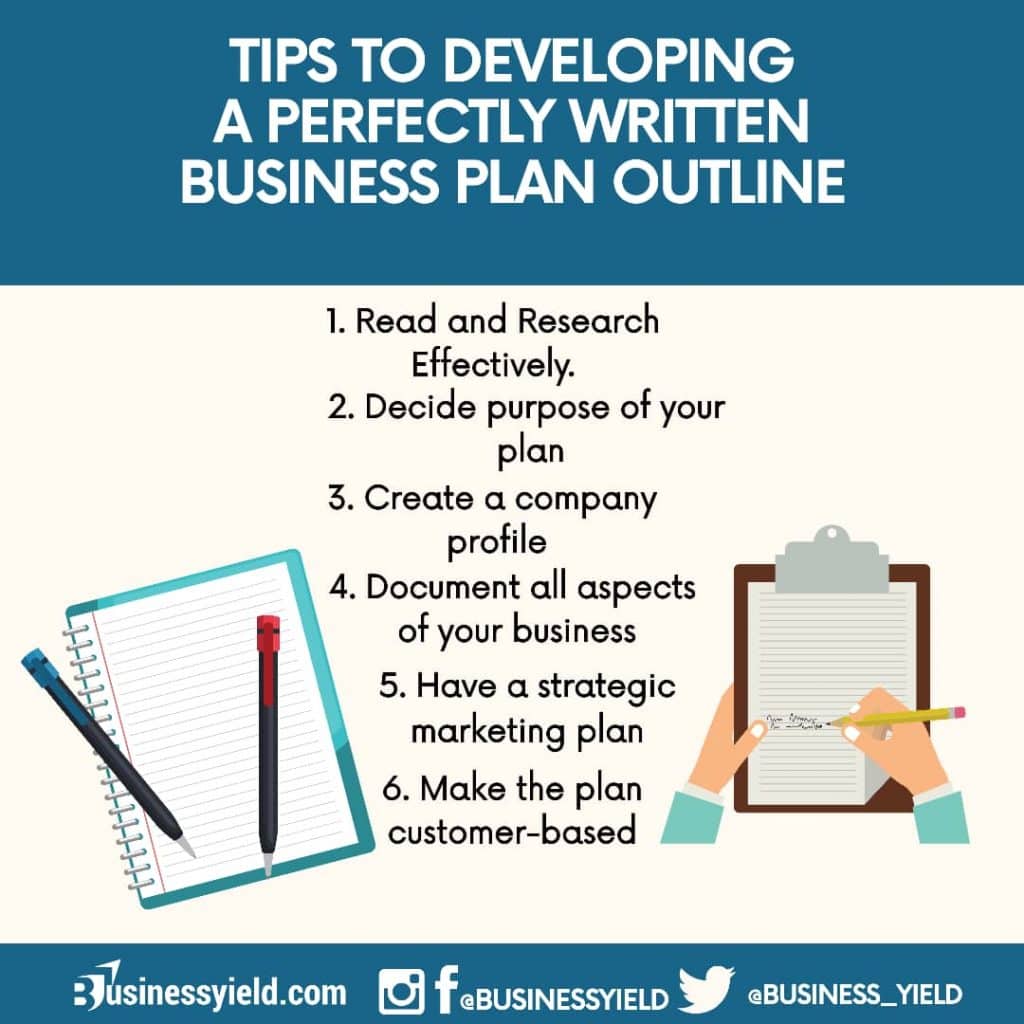From the post, Business Plan Sample, we were made to think that a business plan has to follow a standard format. Actually, not every business needs that professional outlook. Some businesses just require an outline for themselves and their team members. In this article, we have the steps to developing that business plan outline for your small business.
What usually deters entrepreneurs from developing a business plan outline is the time to do so. They believe a business plan format takes a lot of time to develop. In addition, many are afraid that their brilliant idea isn’t so brilliant on paper after all.
Taking time out to research and write a plan makes you identify risks and possible roadblocks. Business plans are essential to identifying and overcoming obstacles on your path so you can build a successful empire.
6 Steps to Developing and Writing a Business Plan Outline
Before you can develop a business plan, there are researches that are ought to be carried out and information needed for the outline to help the business succeed.
Here are 6 easy steps to developing a business plan;
#1. Read and Research Effectively
To write that perfect plan, you must know your company, your product, your competitors, and the market.
That is to say, it is mandatory to know everything you can about your business and the industry you are entering. Read everything you can about your industry and talk to your audience.
William Pirraglia, a retired senior financial and management executive said: “Consider spending twice as much time researching, evaluating and thinking as you spend actually writing the business plan”.
#2. What is the Purpose of your Plan?
In our earlier article, we explained that a business plan can serve various purposes.
It can be used as a fundraiser to attract investors, as a business roadmap to plan for a business’s future, etc. Your business plan should depict whatever the business plan is being drafted for.
However, if you want to attract investors, you will have to write a plan that targets them so it will have to be as clear and concise as possible.
When you define your plan, make sure you have defined its goal as well.
#3. Create a Company Profile
In developing a business plan, you need a company profile.
Your company profile includes the history of your organization, what products or services you offer, your target market and audience, your resources, how you’re going to solve a problem and what makes your business unique.
#4. Document all aspects of your business
The basic objective of a business is to make profits. Investors want to make sure that your business is going to make them money.
Because of this expectation, investors want to know everything about your business. To help with this process, document everything from your expenses, cash flow, and industry projections. Also, don’t forget seemingly minor details like your location, strategy and licensing if needed.
#5. Have a Strategic Marketing Plan
Let us simplify this step a bit.
Your marketing plan should have an objective phase and the implementation stage.
In the objectives section of your marketing plan, you focus on ‘what’ and ‘why’ of the marketing tasks. The implementation section focuses on practicals. The ‘how’ of the marketing tasks; how you intend to achieve those objectives.
For example, a typical marketing objective includes:
- Introducing new products
- Increasing the market for existing products
- Entering new markets
- Boosting sales. Be specific.
- Entering into long-term contracts with some clients
- Raising prices without cutting into sales figures
- Enhancing manufacturing and product delivery
The ‘how’ for introducing a new product will be;
- What exact steps do I need to introduce a new product? Is the product wholly manufactured by me or assembled? etc
#6. Make the Plan Customer-based
The potential readers of a business plan are different people, ranging from bankers and venture capitalists to employees. And each reader has certain interests.
Because of this, make sure that your plan can be modified depending on the audience reading your plan. However, keep the modifications limited. This means that when sharing financial projections, you should keep that data the same.
For example, bankers will be more interested in balance sheets and cash-flow statements, while venture capitalists will be looking at the basic business concept and your management team. The manager on your team, however, will be using the plan to “remind themselves of objectives.
The data will be the same but the explanation varied.
Developing a Business Plan Outline
A business plan format consists of 8 main sections.
Read Also: Why you need a Mentor as a Startup
The format highlighted briefly.
- Executive summary – A synopsis of your business
- Company description – Describes what you do
- Market analysis – Research on your industry, market, and competitors
- Operational plan – Daily activities of the company
- Organization and management – Your business and management structure
- Service or product – The products or services you’re offering
- Marketing and sales – How you’ll market your business and your sales strategy
- Financial projections and plan – Information like balance sheets. How much money you will need for the next 3 to 5 years.
- Appendix – An additional section that includes résumés and permits
Do download the PDF below to get the full details on the outline and what to include or leave out. Each section of the business plan has been discussed extensively.
DOWNLOAD PDF
How to Put Your Business Plan Together
There is no specific order for your business plan, with the exception of the executive summary, which should always come first.
Beyond that, the order is determined by your objectives.
If the goal of drafting a business plan is to help you organize, gather information, and establish a roadmap, organize it in the most natural way for your process. You may bundle comparable stuff together, such as all market-related material (industry overview, marketing analysis, competitive analysis, and marketing plan).
If you want to get money, build your plan around what your audience values and start with the greatest, most convincing stuff. If you have a fantastic collection of people on your new company’s advisory board, put that part right after the executive summary. Highlighting your new company’s capabilities will entice your reader to keep reading your plan.
Include a Title page and a table of contents.
After you’ve finished all of the sections, make sure to include a title page at the front of the plan, followed by a table of contents that lists each section with page numbers.
The Appearance of Your Business Plan Is Important
If you’re developing a business plan for your own eyes only, feel free to experiment with style and arrangement; the simple act of putting all your ideas into a realistic template may be a useful brainstorming tool. However, if you’re searching for money or investors, the business plan should be formatted as a professional document. Your business strategy should impress your potential funding source in every way.
Check the margins and formatting; make sure it’s spell-checked and linguistically correct. If you’re not excellent at this, hire someone who is.
Regardless of how experienced you are, hiring a professional to design, edit, or analyze your business plan may be a good idea; a fresh pair of eyes may sometimes discover difficulties that the original writer missed.
If you require printed copies, choose a competent printer and binding service. Remember that you may only have a limited amount of time to market your idea, and first impressions are quite powerful.
Did this article meet your demands? Leave us a comment in the comment box.
What Is the Outline of a Business Plan?
Business plans typically begin with an executive summary and company overview, then proceed to background research and analysis on the industry, customers, and competition, describe the company’s intended methods in the marketing and operation plans, show who is on the management team, and conclude with the financial.
How Many Pages Should Be in a Business Plan?
A business plan’s three main goals are to 1) develop an effective growth strategy; 2) determine your future financial needs; and 3) attract investors (including angel investors and VC investment) and lenders.
- 7 Tried And Tested Marketing Strategies To Drive Revenue
- Affiliate Marketing for Beginners (20+ Companies to start with) +free courses
- Project Scope Statement: Guide for Creating a Scope Statement with Examples
- CONTENT MARKETING STRATEGIST: Definition, Role & How to Become one
- Company Profile: 10 Simple Steps to Write Company Profile







